What Percent Of Animals Get Hit By A Car What Percent Of Animals Get Hit By A Car In The Us
Driving an average of over 13,000 miles a year, American drivers witness enough on their commutes. Heading down the route at twoscore, 50, or fifty-fifty sixty-plus miles per hour, it's besides 1 of the last places you'd desire to encounter furry friends. It'due south a serious safety concern that claims both man and animal life, only we rarely end to consider the scale of the issue. In a given year, there are over 260,000 crashes involving animals accounting for 12,000 human injuries, and over 150 human being fatalities.
To avert saddening statistics like the ones above, it'due south of import we remove wildlife equally safely as possible from roadways where they may exist injured and put drivers in dangers too.
How often are we experiencing animals about our roadways, shoulders, and medians? Practise we all use the same tactics to avoid these creatures? Are their areas of the U.s. where accidents involving animals are more probable? Read on to detect out the answers to these questions, and learn how over 1,000 young man Americans feel when they've had a run-in with an fauna on the route.
LIKELY Beast ENCOUNTERS
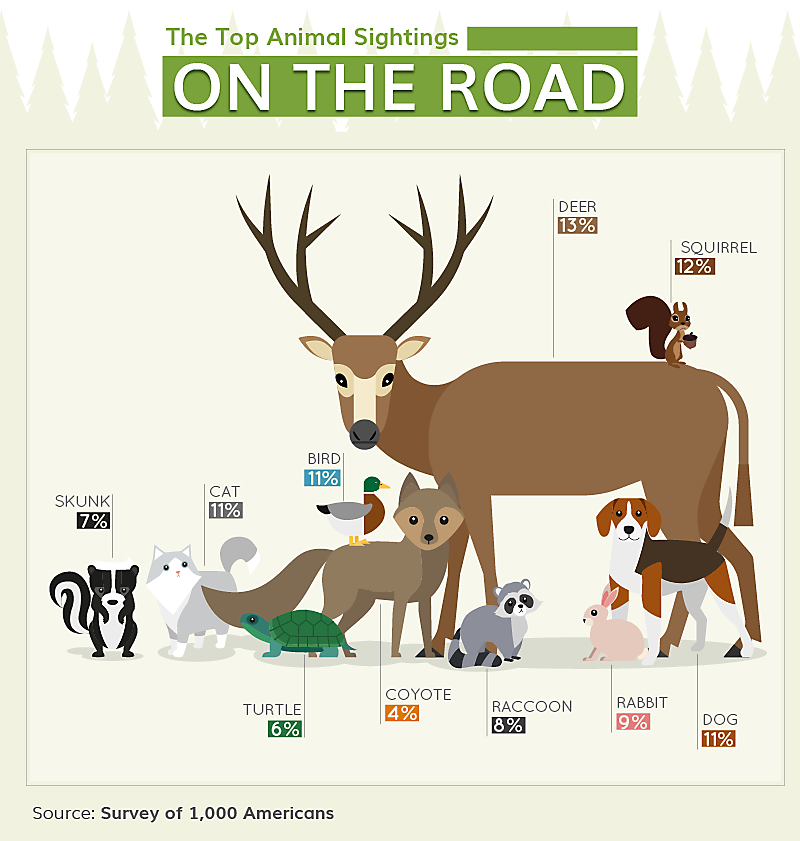
Every bit there are over 30 million deer in the Usa, information technology may not be a surprise that they were the near commonly spotted animal past respondents. While they may exist regal to expect at, accidents with deer are costly. Collisions involving animals account for $4 billion annually.
Some of the other popular animals seen were squirrels, cats, dogs, and birds. Helping ensure these animals stay safety on the road today and tomorrow, specially with the advent of driverless cars, will be a challenge, according to researchers. This is due to the reality drivers face when they spot an animal on or near the road and having to guess what they should do next. Beingness attentive is the first pace to helping keep the roads clear for all the critters we come across.
According to the Wildlife Collision Prevention Program, there are steps you tin can take to ensure you and the wildlife stay safe:
- Be aware of wild animals warning signs
- Lookout your speed
- Drive defensively, not offensively
- Consider whether it is rubber to swerve
- Think "what if" an animal ran into the road; what would your tactic be to avoid information technology?
Mutual COLLISIONS
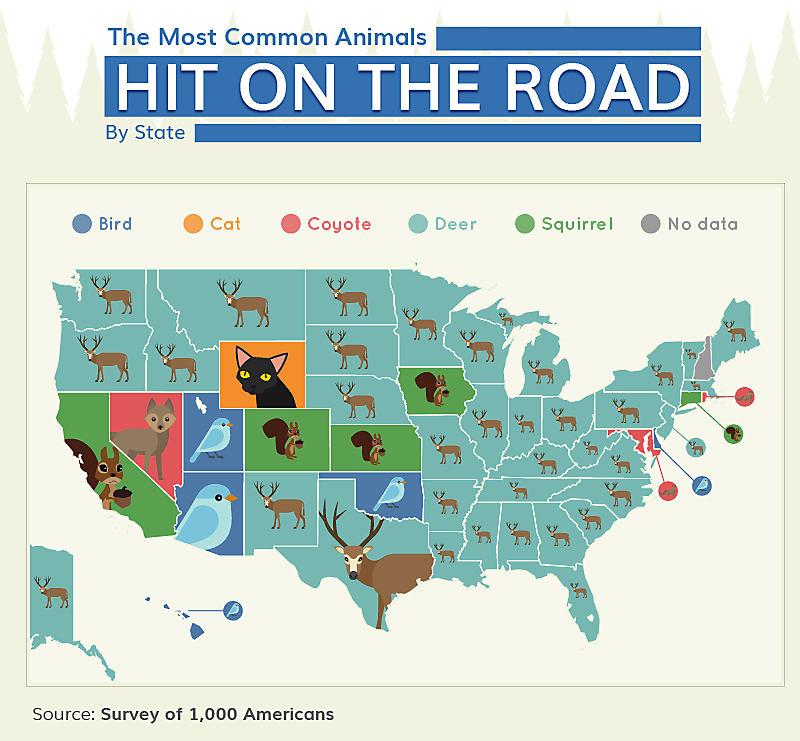
In over seventy per centum of the 50 states, the virtually commonly hit animal on the route is the deer. From some of the well-nigh isolated states, like Alaska, to some of the sandiest, similar Florida, deer lead equally the top victim of motorists more whatever other fauna. In five states – Hawaii, Arizona, Utah, Oklahoma, and Delaware – believe it or not, birds are the most struck creatures by motorists. In 2014, it was reported that over 340 million birds were killed on U.S. roadways each year. Co-ordinate to U.s.a. Today, higher speed limits and wider roads in rural areas have contributed to an uptick in bird fatalities. Non all animals have to exist on the ground to be hit; low-flying birds, fifty-fifty large ones like befouled owls, are susceptible to being struck by a fast-moving vehicle.
There were at least two states where coyote and squirrels were the about commonly struck animals, but but one land, Wyoming, led with cats. This is a state that amassed over 12,000 motor vehicle collisions with animals between 2011 and 2015. These crashes resulted in just over 20 man casualties since 2006.
Common ROADS FOR Animate being ENCOUNTERS
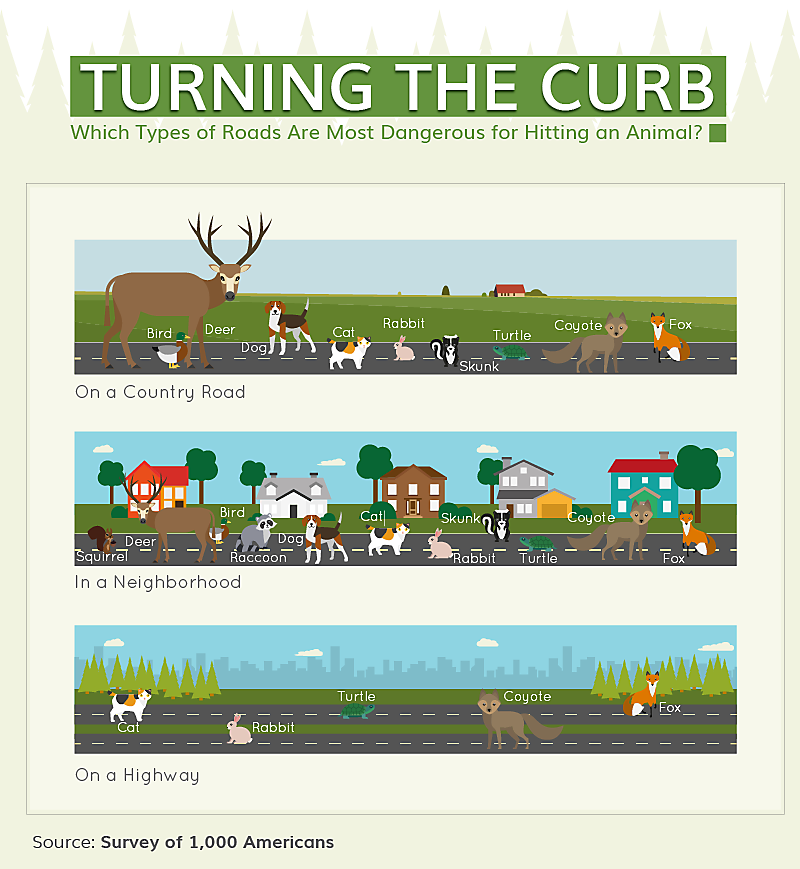
Squirrels were the nigh likely animal to exist struck by our respondents. It'due south dangerous for squirrels in any location equally everywhere y'all'd await them to exist – neighborhoods, country roads, and highways – were the top locations where motorists striking these creatures.
Neighborhoods and state roads proved to be combat zones for virtually every creature. Birds, deer, dogs, cats, rabbits, and skunks were all struck more often on these roads.
SAVING AN ANIMAL LIFE BY SWERVING, STOPPING, OR GETTING LUCKY
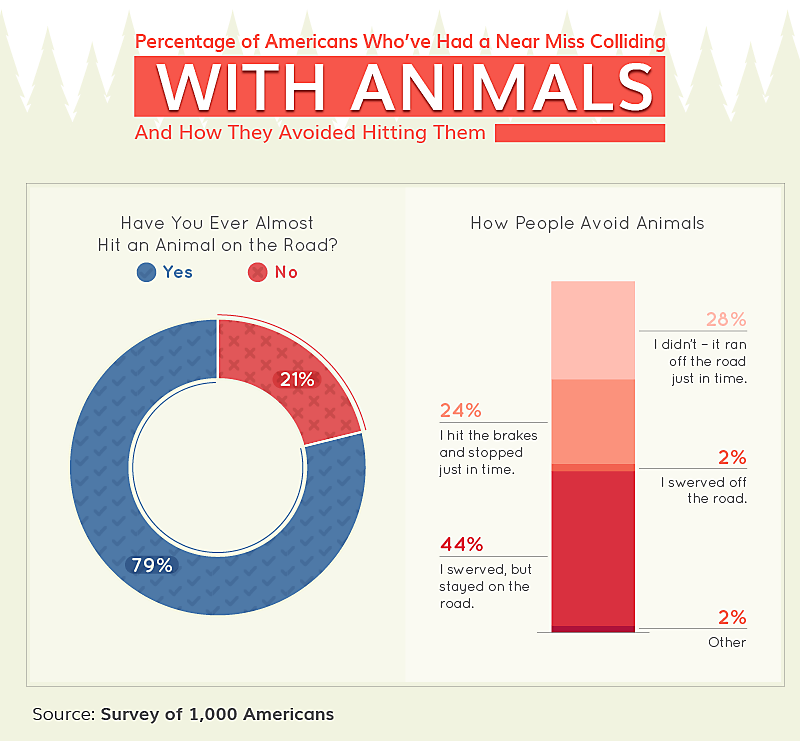
No one wants to strike an animal. Not just is it scary for the driver and passengers, but it can as well exist heart-breaking. About drivers do whatever they tin to avoid hitting animals on the road, just in that split 2d, they are faced with making a difficult choice.
Near drivers – nearly 80 percentage – reported having had a "about-miss" moment with an animal on the road. This means many of us take been faced with the harrowing experience at least once, torn between four or five different reactions, with but a divide-2nd to make a conclusion. Make up one's mind correctly, and the fauna is rubber – and you and those in your vehicle should walk away from the scene. Choose poorly, however, and it could cost not just coin, just the lives of animals and loved ones.
What did the majority of those people who experienced a "almost-miss" decide to do? Close to 45 percent swerved (only stayed on the road) to avoid the animal. Across that, the decision to do nothing came in side by side, likely hoping for (and thankfully seeing) the beast run off the road. Those who didn't choose either of those options ended up hitting their brakes to avoid a collision (24 per centum), swerving off the route (2 percent), or employing some other tactic to avoid an accident (2 per centum).
STOP, SWERVE, OR STRIKE?
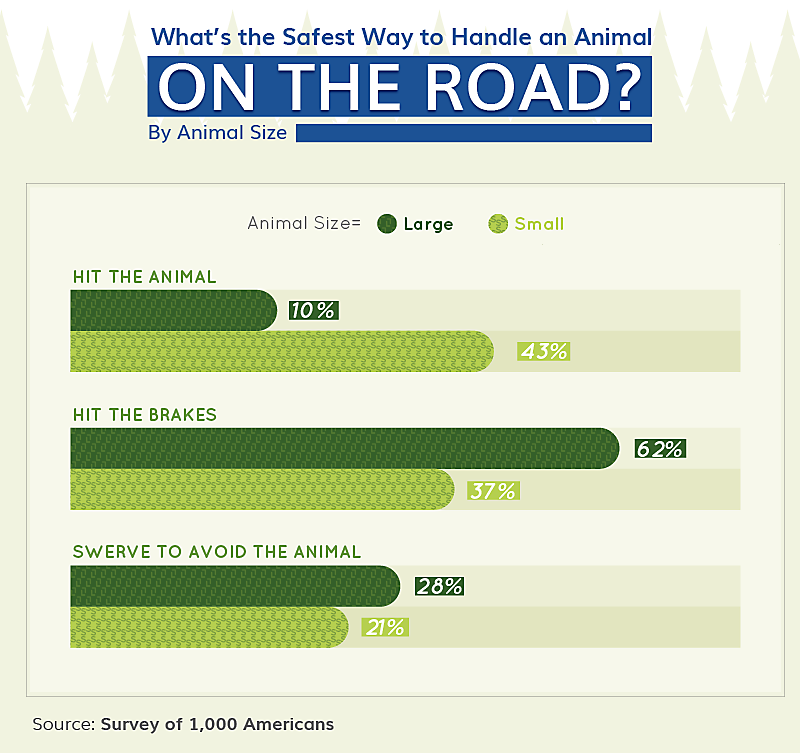
When it comes to encountering animals on the route, information technology's possible to come up across both pocket-size (dogs, squirrels, rabbits) and big (bears, deer, moose) creatures. Given the disparity in size, there are different schools of thought when it comes to safely avoiding one of these species on the road.
Over twoscore percent of the ane,000 Americans surveyed believed hitting a small animal was the safest way to avert an blow. It is not the ideal situation; no one wants to hurt or kill a small animal, just swerving could ultimately lead someone to lose control of their vehicle. A resulting crash may injure pedestrians or other motorists or, worse, cause loss of life.
Information technology's unfortunate, merely hitting an brute may sometimes be the best mode to protect yourself, according to police enforcement officials. This is even more true with larger animals, such as deer, where the average car repair can run shut to $three,000 or more depending on the vehicle. Nevertheless, less than 10 per centum of people would opt to hit a larger animal. Officials also suggest hitting your brakes if no one is behind you lot, and information technology's prophylactic to do so. Over sixty percent of our respondents said they preferred this solution when information technology came to an animal of greater size. The best case scenario would be to avert injury to both yourself and the beast, of course, but sometimes that option isn't bachelor.
FATAL CAR CRASHES
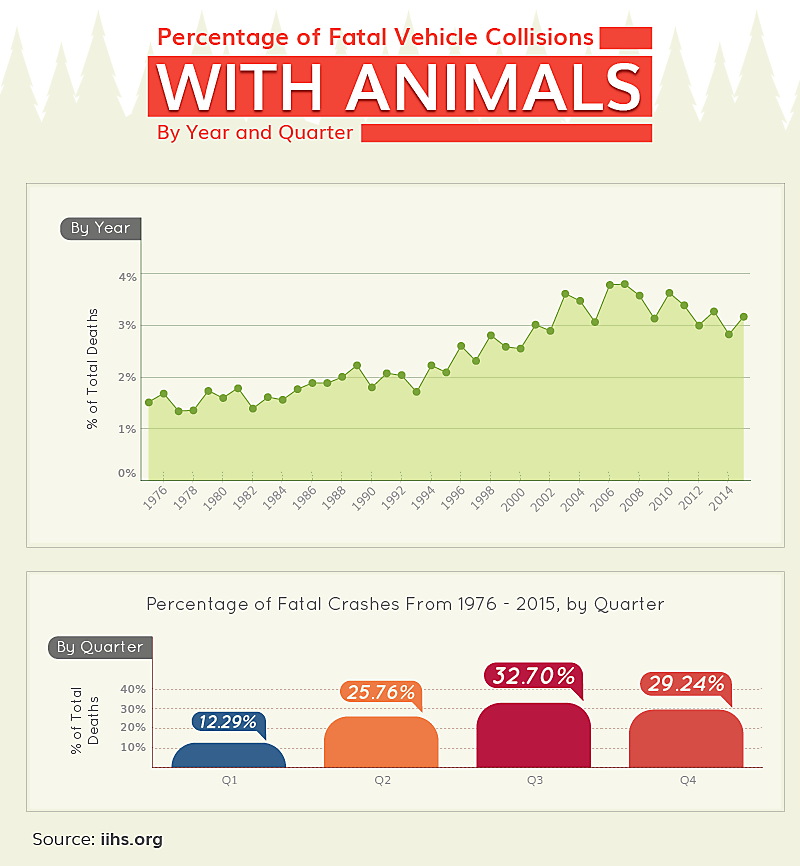
Almost 6,000 deaths accept been attributed to a motor vehicle crash involving an animal since 1975, according to the Insurance Constitute for Highway Safety (IIHS) and Highway Loss Data Institute (HLDI). Over this twoscore-year menstruum, the number of deaths in a single year peaked during 2007, when 223 people were killed in these incidents – almost 4 percentage of the total fatalities recorded. Since 2010, no yr has seen more than 200 deaths as a result of motor vehicle collisions with animals.
Most of these animal-related deaths occurred between the months of July, August, and September – the tertiary quarter of the yr. Every twelvemonth during this span, nearly 50 people across the United States were on a drive, collided with an creature, and never made it home. While nearly a third of the deaths resulting from a motor vehicle collision with an animal took place in this quarter, it was followed very closely by the 4th quarter – October, November, and Dec.
DEADLY ANIMAL COLLISIONS
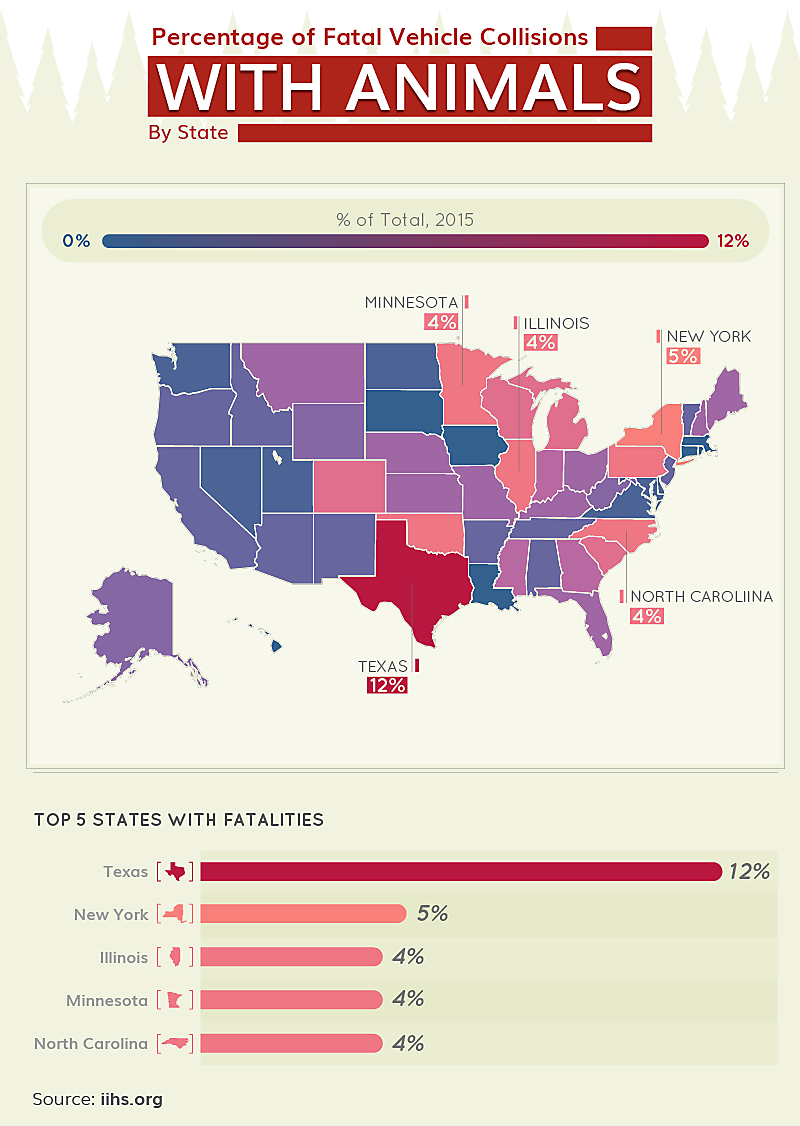
This graph looks at the percentage of vehicle collisions that involved an animal that was fatal to the people in the car. In 2015, of all accidents that occurred, but a pocket-sized percentage involved an animal. The highest percentage was in Texas, which recorded 12 percent of fatalities.
Illinois, Northward Carolina, and Minnesota recorded 4 percentage each of all fatal crashes that involved an beast.
Though these percentages are small, they can be reduced fifty-fifty further by taking preventative measures when information technology comes to wild fauna on the route, including safe removal, which will protect both the man and creature.
Incident Details
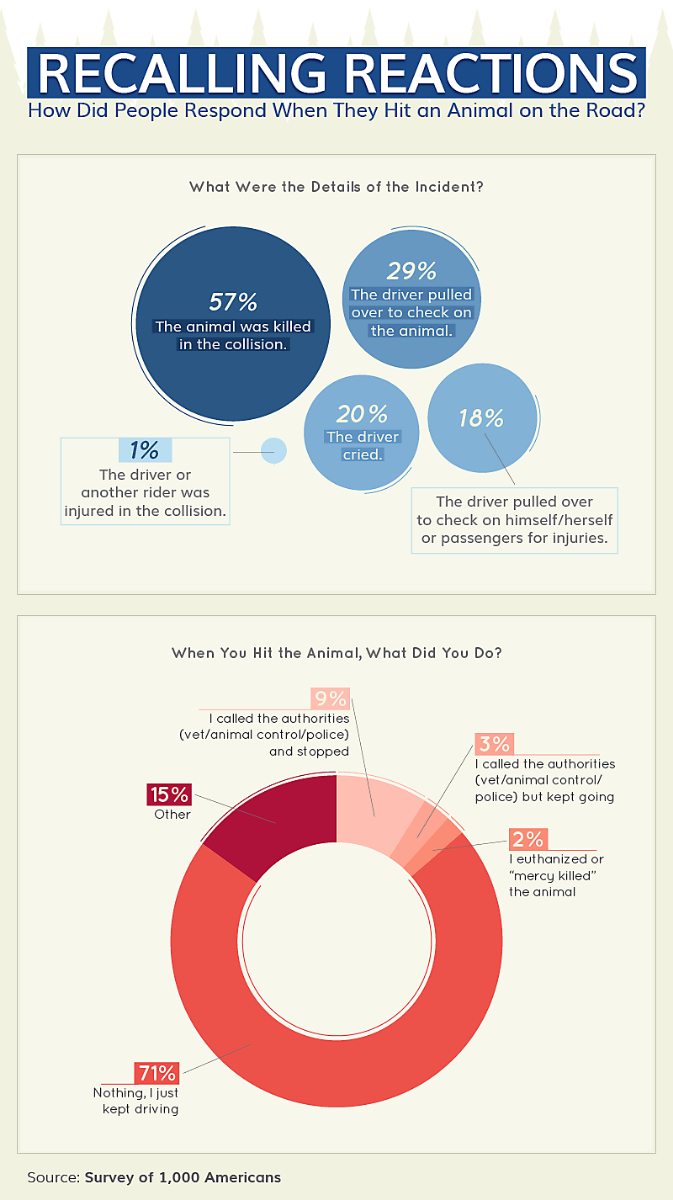
Co-ordinate to our survey participants, the creature in the road was killed in almost lx percent of collisions. More than one-quarter of respondents (29 percent) said they pulled over to check on the animal to see if anything could be washed. At least for the humans involved, only ane percentage had a driver or rider who was injured as a result of hitting an fauna.
Afterward hitting an animal, over 70 percent kept following their GPS or equivalent directions to become to where they needed to exist. With 20 percent of people reporting they cried after hitting an animal. Nigh nine per centum took the time to call the authorities – who would potentially be able to either rescue, euthanize, or dispose of the brute – and waited for them to arrive. This was three times more than likely to occur than the times they simply chosen the authorities and continued driving away.
Upsetting Circumstances
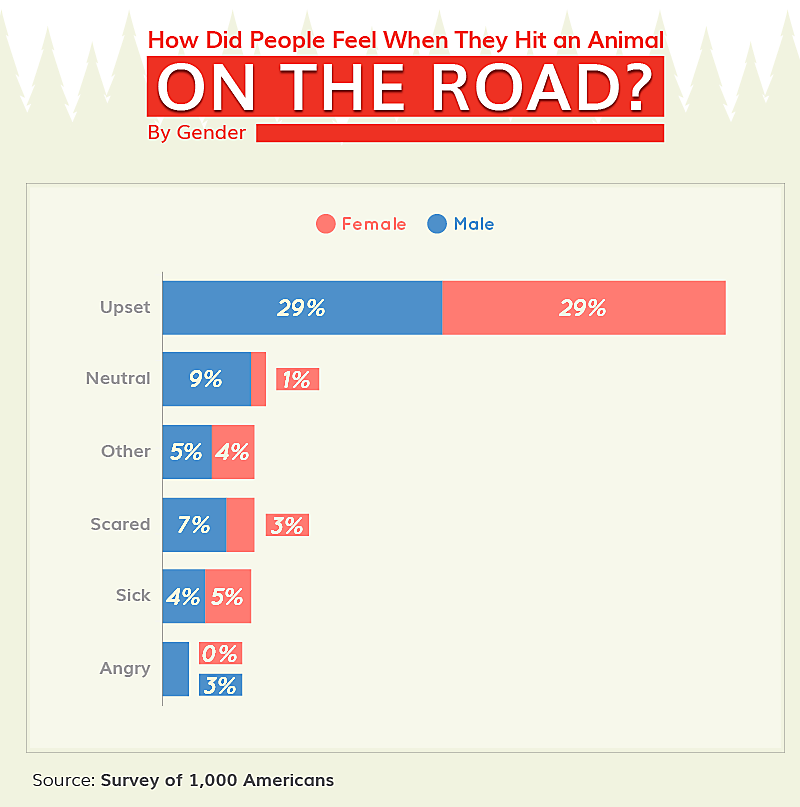
It'southward both unsettling and heartbreaking to hit an animal while on the route. Practicing safe driving is of import, but accidents can happen to the all-time of u.s.a.. When an animal was involved, nearly xxx percent of both men and women felt understandably upset.
Men, more then than women, were likely to feel indifferent. Almost 10 per centum said they had a neutral feeling after hitting an animate being, compared to just 1 percent of women. The second most likely emotion a woman would experience after hitting an creature was sick (5 percent). Who would be aroused about it? Almost 3 percent of men.
WHAT CAN You lot DO TO Forestall FATAL ANIMAL COLLISIONS?
In that location are a few things you can practise to avert a collision with an brute while driving, merely there is plenty y'all can do off the road to make the roads safer for drivers and wild animals.
You can back up efforts that button for wildlife conservation with express highway construction.
You can also remove the animal from the roadway if it will not put you lot or the animal in danger, or telephone call your local animal control to assist with the removal and rehoming of the fauna.
For domestic animals, such every bit dogs and cats, spay and neuter to aid command population spikes.
Your local council members, Congress members, and Department of Transportation can fifty-fifty exist chosen to ensure correct wildlife crossing signage is posted where information technology is needed. Lastly, y'all can support structure efforts to create wildlife crossing bridges like in Arizona.
Determination
Motor vehicle collisions involving animals and the fatalities associated with these incidents are no laughing thing. While these accidents cause around 200 deaths a year, information technology is besides about the amount of injury and damage that occurs to both humans and animals alike. Depending on what state you live in, such as Texas, or where you're driving, such as neighborhoods or land roads, you may exist more likely to be in a situation where striking an animal with your car could happen. Havahart is helping to control animal populations in a caring way, and an animal population that is nether control ways potentially fewer animals in harm's way.
Beingness attentive while driving could help to salvage an animal's life, not to mention your own.
METHODOLOGY
We surveyed ane,000 people in the United States about their experiences with wildlife on the roads. Additionally, we sourced fatal crash data from iihs.org.
FAIR Apply STATEMENT
If you lot wish to share the findings of this article with your own audition, don't be an fauna, delight link back to this page to give the author proper attribution.
Source: https://www.havahart.com/wildlife-on-the-road
Posted by: jacquespueed1957.blogspot.com

0 Response to "What Percent Of Animals Get Hit By A Car What Percent Of Animals Get Hit By A Car In The Us"
Post a Comment